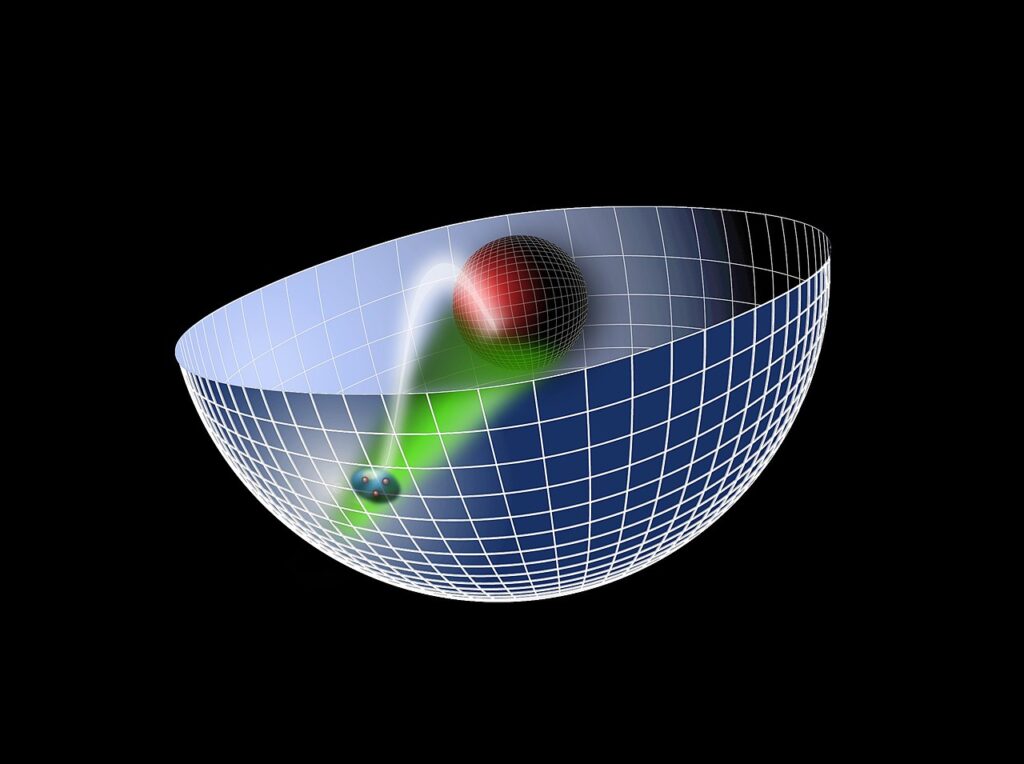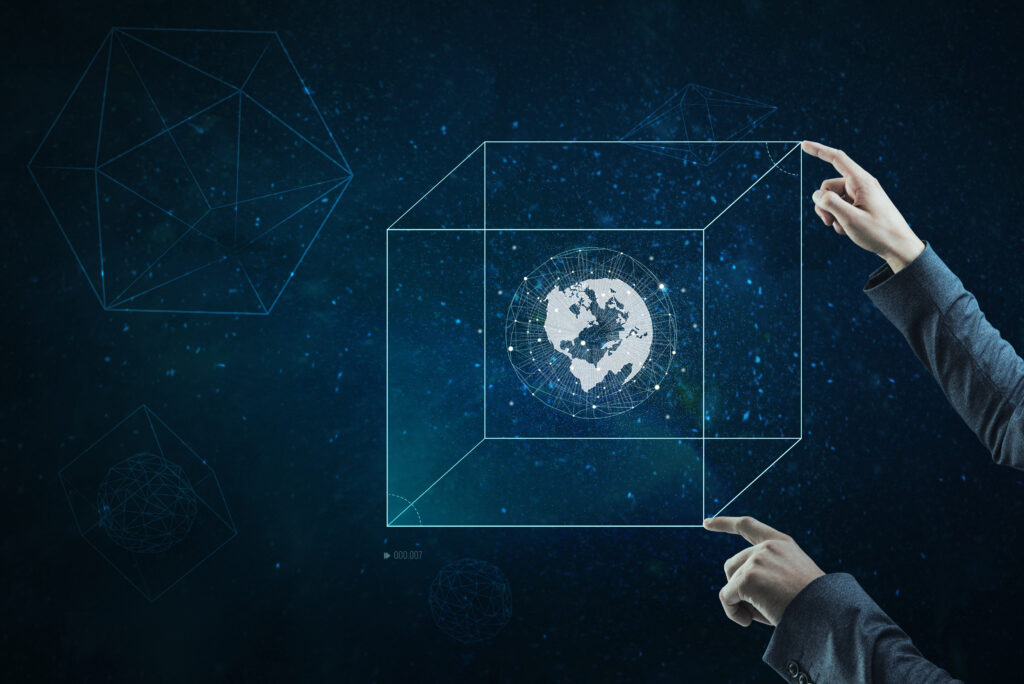
This artist rendering visualizes a proton in Anti-de Sitter (AdS) space, a negatively curved theoretical realm crucial for studying gravity. The holographic universe theory proposes a fascinating duality, connecting AdS space with a two-dimensional Conformal Field Theory (CFT) on its boundary. This theory suggests that gravity could emerge as a holographic projection from the 2D CFT, offering profound insights into the fabric of the cosmos. A captivating tool in theoretical physics, the AdS/CFT correspondence unveils the potential holographic nature of our reality. Thus, the image of the proton in the AdS space is a visual representation of how a 3D object (the proton) can be described by a 2D boundary theory. Image: SLAC National Accelerator Laboratory.
By Mariana Meneses
How real is space?
Physicists have puzzled over what happens if a black hole “dies” – the black hole itself being the result of a collapsed star. They wanted to know: where does everything the black hole consumes go, when the black hole itself disappears – either by extremely slow evaporation or some other means?
Looking for an answer by studying the event horizons of black holes, they have found that space might not even exist independently of an observer, but arise as an emergent phenomenon, as some argue human consciousness does. This would mean that the fabric of spacetime, as we observe its three dimensions of space and one dimension of time, has properties that neither space nor time have on their own. Instead, the theory says that the combined fabric only emerges when its parts interact – and are perceived, or synthesized, by our perception.
The event horizon is the theoretical boundary of a black hole. Events that might occur within the boundary cannot affect an outside observer and the pull of gravity is so strong that not even light can escape the event horizon. The dimensions of space and time appear to end at the event horizon, although it is not possible to observe physical objects passing through the horizon.
“The black hole’s extreme gravity alters the paths of light coming from different parts of the disk, producing the warped image” (NASA’s Goddard Space Flight Center)
Black holes, where space and time appear to end, distort the fabric of spacetime.
Their enormous masses make gravity so intense that not even light can escape from them. Everything that falls into a black hole will become part of it for eternity, or at least this is what we used to believe until Stephen Hawking proposed in the 1970s that black holes could evaporate.
He argued that black holes emit a specific type of radiation, now called Hawking radiation, and since energy is directly connected to mass in general relativity theory, this would mean that black holes are constantly losing mass via radiation. In other words, if a black hole is not consuming more mass than it loses by radiation, it will shrink until its mass disappears.
This seems to correspond to the principles of Albert Einstein’s theory of general relativity, but the idea goes against one fundamental pillar of quantum mechanics which is that information can neither be created nor destroyed. Thus, it highlights the ongoing challenge of reconciling general relativity with the operation of the universe at the tiniest level of the quantum, which is the minimum unit of energy in the universe that can either cause change or be changed.
Everything in the universe contains information, which at the minimum level is called “quantum information.”
The information is encoded in the properties of atoms and the subatomic particles that form any object, be it me, you, or the screen you are using to read this article right now.
In theory, if we know all the quantum information of a system, we can recreate parts of it that have been lost. This results from something called quantum entanglement, the connection between two or more quanta in which one quantum pairs with others across a potentially vast distance so that what happens to one instantly influences the others with no delay for time.
“Quantum entanglement is the physical phenomenon that occurs when a group of particles are generated, interact, or share spatial proximity in a way such that the quantum state of each particle of the group cannot be described independently of the state of the others, including when the particles are separated by a large distance. (…) Entanglement is a primary feature of quantum mechanics not present in classical mechanics. (Wikipedia).
But if information can never be destroyed, what happens when a black hole evaporates – where does all the information go?
This is the famous black hole information paradox. Decades-long debates have been fought between relativists and quantum physicists over this paradox until, in the 1990s, physicists Dr. Gerardus ‘t Hooft (Nobel in physics, 1999) and Dr. Leonard Susskind proposed an answer.
Decades-long debates: Leonard Susskind and Stephen Hawking conducted a famous debate on the question of information loss in black hole evaporation. For more on the topic, refer to the book The Black Hole War, published in 2008 by Dr. Leonard Susskind.
Their idea was that when an object falls towards the center of a black hole, the information is recorded in the event horizon. It’s as if the object is being scanned, and an image of its three dimensions saved in two dimensions in the region of its infalling trajectory. This would operate much like the logic of a hologram.

Could the world be a hologram in the metaphorical hands of others? Illustration: Twin Peaks on Flicker.
A hologram is a three-dimensional projection of information recorded in two dimensions, in which the dimension of depth is imputed from two dimensions of length and width.
Imagine you have a book that falls into a black hole. The book would forever become part of the black hole, however a perfect image or copy would be recorded and saved in the event horizon. This information could be used by a computer or some other technology to recreate the book in all its three dimensions – if you could somehow collect all the data in digital sequences indicating the limits of beginning and end that define all the components of the book.
“Imagine everything that falls into a black hole. You could describe it with a long binary sequence of ones and zeros, or bits. And if you’ve got an algorithm that decodes that, it’ll tell you what fell in. The information is the smallest binary string of bits that is sufficient to completely tell you about the thing that fell in, whether it’s a book or a bunch of quantum bits or, you know, a star collapsing,” explains Dr. Jeff Forshaw, from the University of Manchester.
“This is determinism, which is central to physics. If you know everything about a system at one point, then you can predict what it’s going to do in the future and what it was doing in the past,” adds Dr. Brian Cox.
Holograms are now present in our everyday lives, being widely used for many applications of modern technology like artistic productions (such as films) and in constructing maps.
One of holography’s main applications is storing large files in computers. To Dr. Cox, “one super-cool thing is how all this relates to quantum computing. (…) Quantum computers are made up of qubits, which can exist in not just a state of zero or one, but a mix of the two. These days, one of the big challenges in quantum computing is to store information in a physically robust way because qubits are very delicate things. The answer is to build a network of interconnected qubits in such a way that that network is robust against damage to the fragile quantum states of some of the interconnected qubits.”
This is the notion behind Microsoft’s Project HSD (Holographic Storage Device for the Cloud), which could revolutionize the way we save digital files.
Last August, The Quantum Record asked whether the universe has a holographic memory that is transmitted in the form of low-frequency gravitational waves recently detected from their effect on pulsar beams emitted by neutron stars.
Following the proposal of ‘t Hooft and Susskind, many physicists began to think that holographic logic does not apply solely to black holes but almost everything in the universe. Moreover, scientists understood that they could apply these ideas, named the Holographic Principle, to far bigger systems than black holes and to the observable universe itself.
Some believe that, just like black holes, our universe also has an event horizon, a region beyond which information exists but we cannot access it. This would happen because the universe is constantly expanding, and there is a region where the expansion is faster than the speed of light, which means that no information coming from there will ever reach us, and we will never be able to observe what happens beyond that point. Just like with black holes!
What if all the information contained inside the volume of the universe defined by its event horizon is actually stored, or encoded, on its surface?
That would mean that everything that exists inside this volume we call the observable universe is a hologram projected from information located on the surface of this ever-expanding boundary.
In 2019, a global network of radio telescopes known as the Event Horizon Telescope released this first-ever image of a black hole, the supermassive one at the center of the nearby galaxy Messier 87. A remastered image of the black hole showed its layers and revealed how photons behave under the object’s tremendous gravitational influence to generate a photon ring, a narrow ring of light caused by the intense gravity of the black hole.
On the basis of many calculations, Dr. Andrew Strominger and colleagues proposed that a black hole’s photon ring has the kind of symmetry that often arises in a hologram, indicating that the photon ring and not the event horizon is key to the holographic principle. These findings were published online in May and recently accepted for publication in the journal Classical Quantum Gravity.
Much more research is needed before scientists can say whether, and how, the photon ring actually encodes all the information consumed by a black hole.
You may be worrying how probable it is that you and I are not “more real” than the holograms produced by modern technology.
Despite its success in theoretical applications, there is still no holographic description of the actual universe we observe. Physicists are actively exploring ways to adapt the holographic principle to a more realistic cosmos with the geometry of our universe. Some researchers are considering the role of time in this context, exploring how an expanding universe might fit within the holographic framework.
It could be that space is not that “real”, at least depending on our definition of reality.
Space can emerge from a large combination of simple constituents, similar to how consciousness seems to arise in the interaction of neurons and synapses in the brain and other biological systems.
To Dr. Forshaw, “All that really exists is information. Space and time emerge from a bunch of entangled quantum units that have logical relationships with each other. These units, we’re not quite sure what these are, they could be like qubits or something, but they interact with each other quantum mechanically. And the result of that is the universe we live in”.
Given everything discussed, we could all be falling through the horizon of a black hole right now and we wouldn’t know. Reality is, and has always been, more dependent on our positions as observers than we might have ever thought.
Craving more information? Take a look at these recommended TQR articles:
NASA’s Hubble Space Telescope and Chandra X-ray Observatory
Does the Universe Have a Holographic Memory?
James Webb Space Telescope Advances Search for Signatures of Life
Space Exploration Technology Opens A Window On Time
James Webb Space Telescope: Hubble’s Successor May Rewrite the Physics Books



